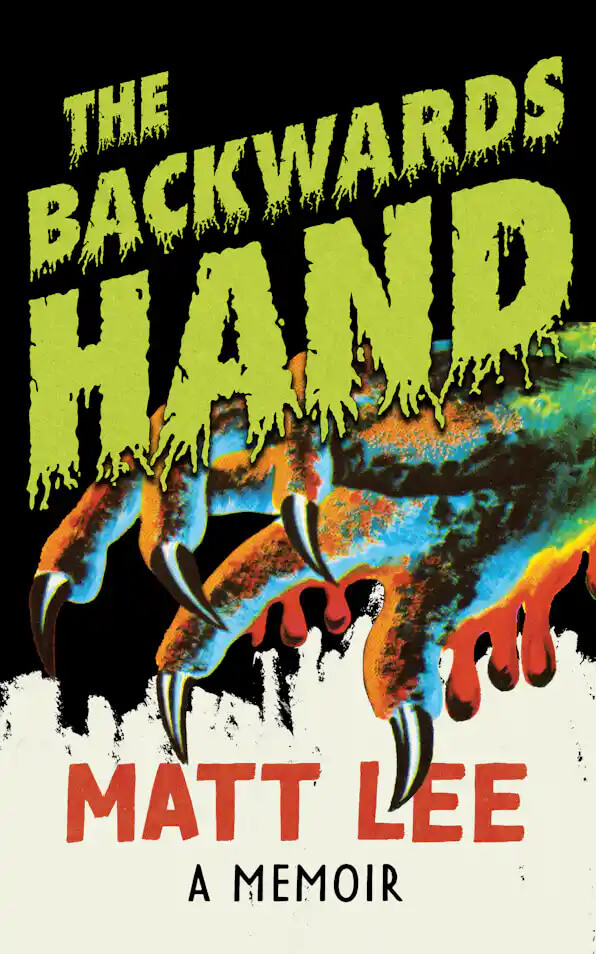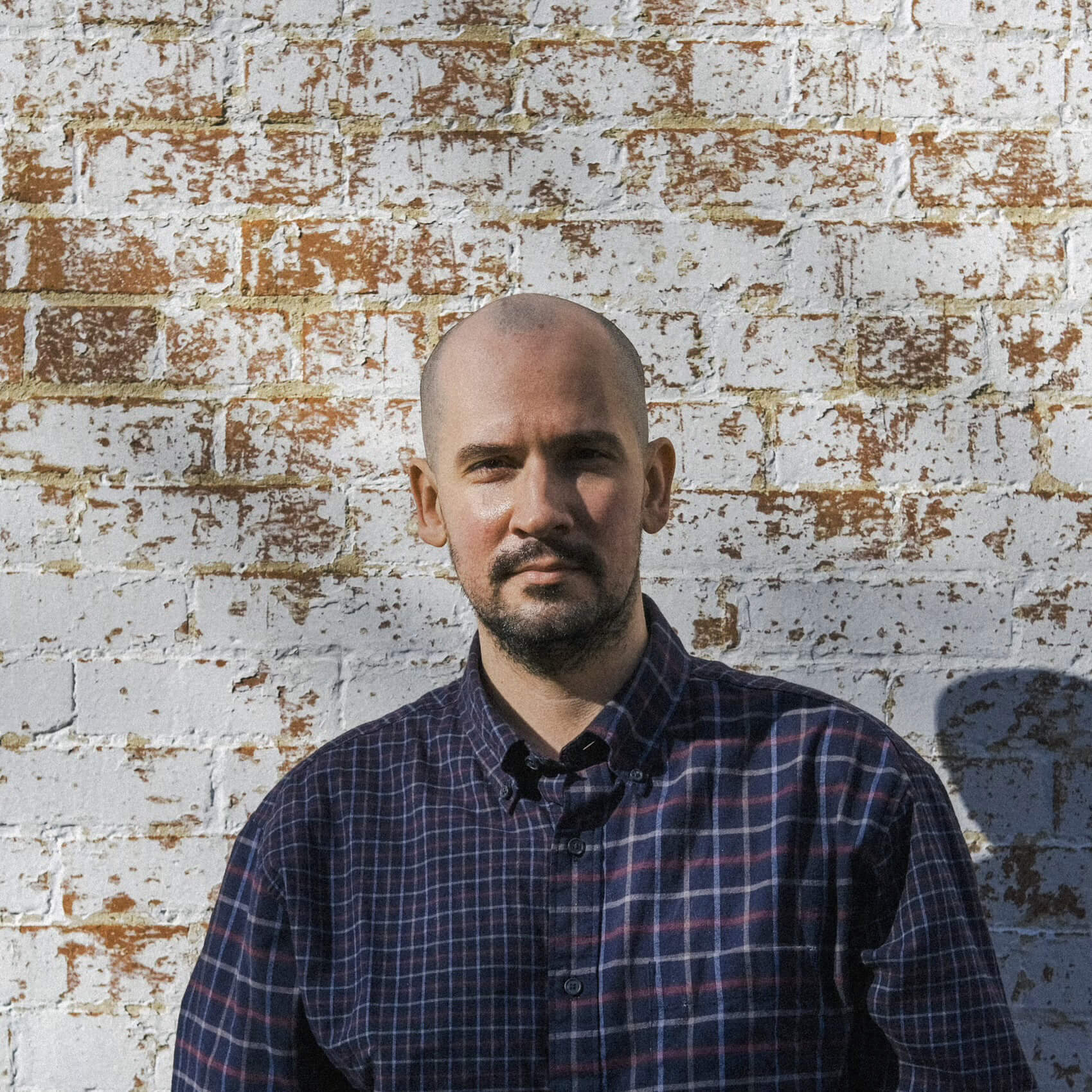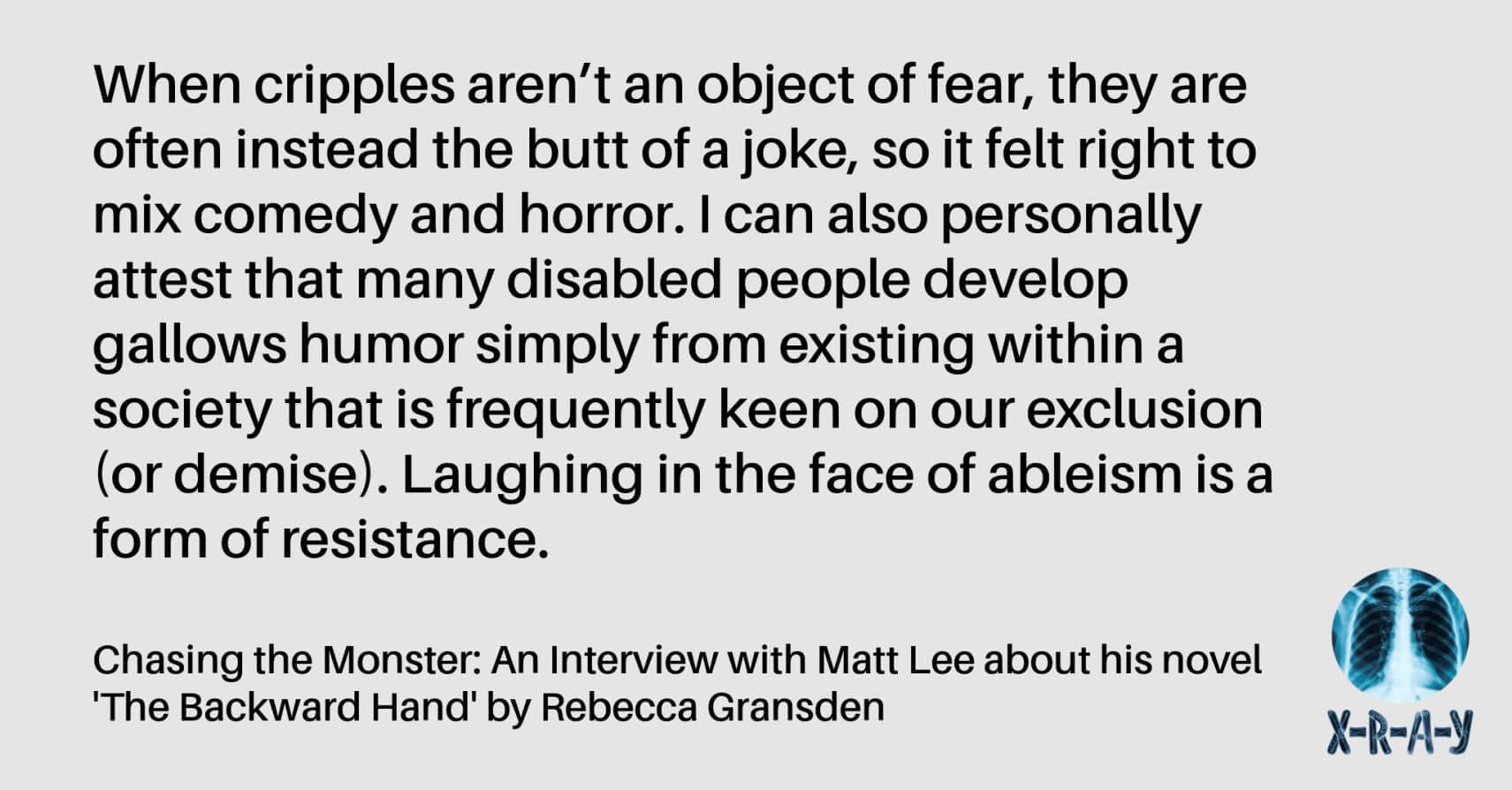Where lives the creature? The Backwards Hand: A Memoir (Curbstone Books, 2024) chronicles Matt Lee’s experience of growing up and into adulthood. Matt’s hand marked him out as different, and it is the nature of this difference, where it resides, that comes to the fore. Out from the unconscious arises the monster, but once unleashed, even a monster must live in the world. As the monster is seen, is reflected, perhaps even reconciled with, it remains powerful but also hard to pin down. In whose eyes, in what skin, does the monster live? I asked Matt if he’s any closer to finding out.

Rebecca Gransden: Fear THE CLAW! Near the start of the book you describe a game of The Claw that you played with your dad. This obviously put me in mind of the Jim Carey film Liar Liar, where Jim’s character uses The Claw as a way to jokily terrify and bond with his son. What prompted you to venture into the domain of memoir?
Matt Lee: You just unearthed a long-buried childhood memory of renting that movie and watching it with my father. We’ve been estranged for many years, but I will give him credit for letting me check out all sorts of bawdy, violent films when I was (probably) too young.
I consider myself a failed poet. Writing creative nonfiction, much less a memoir, had never crossed my mind. I wanted to be a teacher, so I went to grad school (add failed professor to the list). My adviser suggested I enroll in a creative nonfiction course, and I figured it would allow me to get outside my creative wheelhouse. I was soon so enamored that I repeated the class.
One of my assignments was to write the first chapter of a memoir, which became the genesis of The Backwards Hand. At that stage of my life, I was cagey about discussing my disability, and I wanted to figure out why, so the memoir served as a vessel of self-interrogation. When I began framing my story within the larger tapestry of disability studies, I felt even more compelled to share it, to move beyond mere solipsism and invite others along for the ride, a collective investigation into a topic which many prefer to sweep under the rug—our attitudes surrounding the disabled body. 
RG: Facts From Hell! You intercut passages on films with factual historical accounts. Your personal history and experience is recounted alongside cold, hard statistics. How did you go about choosing the structure for the book?
ML: The “literary collage” style is something I adopted and developed while working on my first book, Crisis Actor. The subject of disability is so vast and mercurial that a fragmentary approach felt natural, and it formally mimics the organized chaos of my mind. Throwing this onslaught of information at the reader likewise invokes one of the book’s central concerns: abjection. My intention is for the book to overload one’s sense of being, the same way you might react to seeing a corpse (or a cripple). I use the personal narrative as a ballast—I tell my story in a linear fashion to help ground the erratic miasma of references surrounding it.
RG: You Won’t Believe Your Eyes! The book draws from many sources. What did the research process look like? Were there discoveries that made an impact on you, or the direction of the book itself?
ML: I started with a few key touchstones. Tod Browning’s Freaks, Diane Arbus, Julia Kristeva, etc. Once I went looking for it, though, I began seeing representations of disability everywhere, and the research started to balloon. I had to be diligent about what outside references best complemented the autobiographical portions. The final bibliography includes more than two hundred sources, and there were loads of other “unofficial” sources not directly referenced in the book. What’s ironic is that, despite having been born disabled, I was grossly ignorant about the history of disability, so the journey was rife with discovery, much of which turned my stomach. Learning about eugenics and the mass killing of disabled people in Nazi Germany, for instance, was much more frightening than any horror film and presented opportunities to juxtapose real-world monsters with their fictitious counterparts. It was important to keep the process organic. I let the research lead me.
RG: Behold, the Monster! The book confronts and examines the concept of the monster head on. Physical deformities and abnormalities are understood via the lens of the fantastical, the mythic, Hollywood monsters. The tension of the book lies in the point at which the monster exists in the eye of the beholder and as a universal idea. Did your view of the monster morph over your time spent writing the book?
ML: The monster is a strange conundrum because it is a universal concept, as you mention, but everyone’s criteria of what constitutes a monster is unique. A central question from the book is What makes a monster? The more I considered this question, the less confident I felt in my answer. Ultimately, I think the only fair way to define the monster is by action (the Latin root of the word means “to show,” but do we show by doing or purely by the facade we display?). After all, you can look perfectly ordinary on the surface and still be capable of committing a heinous act. What I most struggled with were notions of culpability and condemnation. Does a single monstrous deed classify someone as a monster in perpetuity? When does the scale of monstrosity remit any chance of redemption? Does even the foulest monster deserve forgiveness, whether or not they ask for it? I continue to wrestle with these questions.
RG: You’ll Die Laughing!
People I know have told me they attempted to go a day without turning their hands and found it utterly impossible. They cannot help themselves. Neither can I.
Humor, sometimes wry, often dark, plays a large part in the memoir. How did you decide upon the tone for the book?
ML: When cripples aren’t an object of fear, they are often instead the butt of a joke, so it felt right to mix comedy and horror. I can also personally attest that many disabled people develop gallows humor simply from existing within a society that is frequently keen on our exclusion (or demise). Laughing in the face of ableism is a form of resistance. Humor is also an excellent tool for disarming the reader. It lulls you into a false sense of security. One line might have you chuckling, the next recoiling in shock. It’s my way of saying, Don’t get too comfortable.
RG: Don’t Look in the Mirror! A recurring theme is that of the mirror. Mirrors are sometimes absent, a source of discomfort, of not wanting to see the reflection. There is projection onto deformity, that a person with a physical disability reflects ideas of decay and disease, uselessness: a mirror showing uncomfortable truths or imagined futures filled with aging or incapacity. Film is also a type of mirror, potentially a cracked or funhouse one. Is The Backwards Hand a mirror?
ML: There’s a strong argument to be made that all art is a mirror, and The Backwards Hand is no exception. My intention is to force the reader to examine their own capacity for monstrosity, to wrestle with their prejudices and biases. That’s certainly what I was doing while writing the book, and I think it’s a healthy exercise to confront the monster within us all. Disability itself is like a window into the realm of possibility—it reveals the human body’s potential, the limits of mortality, which is why it triggers such a strong response. It simultaneously attracts and repels. I hope my book has a similar effect.
RG: Movie Mayhem! One of the great joys of the book is the impressive array of films you cover. Are there films that stand out to you? Any discoveries you made in the gatheration of titles that you’d recommend?
ML: Many of these films surprised me upon revisiting them after a number of years, namely Cronenberg’s The Brood, Roeg’s Don’t Look Now, Medak’s The Changeling, and Cohen’s It’s Alive. Their emotional intensity profoundly resonates with me—I actually found myself crying at the end of It’s Alive during my rewatch. I realized, of course, all these films deal with parenthood and children, so with my being a new father, I was especially sensitive.
In terms of discoveries, I would point to Browning’s The Unknown, a silent-era precursor to Freaks, which boasts an astonishing performance by Lon Chaney. For horror fans, I’d recommend Eric Red’s Body Parts. It’s one I don’t see discussed too often. There’s an incredible sequence of on-screen vehicular carnage, and the whole movie is a lot of fun, with Brad Dourif in peak, deranged form.
RG: A Stage Set for Damnation!
Make a choice. Is the cripple an object of pity or a source of inspiration? Shall you exploit or glorify the invalid? Are you entertained? Disgusted? Amused?
You have a history in the acting world, and have taken on the parts of disabled characters, as unflinchingly implied in the book, a cripple playing a cripple. How is the concept of the mask addressed in The Backwards Hand?
ML: Drama is a philosophically compelling medium because of its paradoxical nature. The actor strives to behave truthfully under imaginary circumstances, but a genuine performance is still a performance, the illusion of something real. I’ve known many actors who say that they “come alive” onstage, as if the artifice gives license to tap into ways of being we might otherwise suppress. Masks can have a similar effect—when the outer self is hidden, the inner self seeps to the surface. The monster, like the actor, often adopts a mask, and this new face gives him courage to act in a new light, typically with grisly consequences. I’m reminded of a character like Leatherface, who dons different masks (in his case, literal faces) for certain occasions.
Is the memoir itself a type of mask? Nonfiction is only a representation of reality and, being limited to the author’s memories and point of view, is inherently fallible. Still, this layer of removal, this distillation of experience into a form, gave me a certain level of courage to be explicit in the way I try to portray myself. Perhaps wearing a “literary mask” can reveal something authentic. In the end, The Backwards Hand is my attempt to strip bare, an unmasking.
RG: The Nightmare of Reality! The stats you include are at once hair-raising and bleakly illuminating. Looking back at the book, at some of the hard truths it presents, what is your personal relationship to these generalized facts?
ML: The scope of something like 300,000 people with disabilities were executed in Nazi Germany is almost incomprehensible, which is why I tend to give statistics in the book a standalone line. Unadorned, they are quite staggering, but I also want the information to not just be numbers on a page. The individual stories illustrate the examples and, most importantly, humanize the cold, hard facts. One of those 300,000 was a little boy named Richard Jenne, whose photograph appears toward the book’s end. It’s a painful reminder that we mustn’t reduce people to data, to abstractions, especially within the context of disability, when logic and science are often used as tools to dehumanize people, and thus provide justification for atrocities.
RG: You Won’t See Them Coming!
Invisible disabilities are those that are not immediately apparent. An estimated 10 percent of Americans fall into this category, myself included.
One area I found compelling is the book’s attempt to grapple with the idea of categorisation. Where does condition end and anomaly or disability start? Where do the terms cripple and invalid come into play? How did you set out to approach language for The Backwards Hand?
ML: This fits into the debate of essentialism versus constructivism, the former arguing that disability is a diagnosed, medical condition, the latter positing that disability is a social construct. Some theorists might suggest that disability does not exist, others that everyone is disabled. And the spectrum is so wide and multifaceted that it resists easy categorization. I do think it’s important to remember that disability imposes very real material conditions on a person, but that no two people experience a disability the same way.
Co-opting outdated and offensive terms like “cripple” and “invalid,” for me at least, is a way to reclaim these hateful words and flip the script. I choose to wear “cripple” as a badge of pride. At the same time, it’s a way to challenge readers to consider the implications of ableist language, much of which is bandied about in everyday conversation without a second thought.
I use pretty plain and straightforward language in The Backwards Hand. The approach I’m going for is understatement. I try to employ an even-keeled tone that belies the often disturbing nature of the subject matter, so the prose sneaks up on you.
RG: Pity the Freak!
The American artist John Callahan was twenty-one when he became a quadriplegic. He’d spent the day barhopping with a buddy, who was driving Callahan’s car when they wrecked. After the accident, Callahan decided to become a cartoonist, gripping a pen between both hands to produce crude but clever one-panel gags. His macabre sense of humor and his tendency to deal in taboo subjects, most frequently disability and disease, landed him a fair share of critics, who decried Callahan’s work as tasteless.
Callahan said his only compass was the reaction from people in wheelchairs or those who have hooks for hands, people like himself who were sick of being pitied and patronized. The truly detestable ones, he said, presume to speak for the freaks themselves.
Assholery is a recurring theme. At the extreme end is assholery of the homicidal and genocidal variety, and at its most mundane it manifests in everyday thoughtlessness and casual bigotry. You don’t spare yourself when it comes to assholery. What place does the asshole have in The Backwards Hand?
ML: Anyone can be an asshole, just like anyone can become disabled. I write about both able-bodied and disabled people who have done bad things, some of which are minor transgressions, others unspeakable acts of evil. I do believe that disabled people have to put up with an immense amount of assholery in our day-to-day lives. There is so much open hostility toward people with disabilities. And what is our crime? Spoiling the scenery. Needing accommodation. Requiring care and time and effort and money. How dare we have the gall to demand such resources without lifting a finger to contribute to the altar of capital! What is most sinister is when bigotry masquerades as mercy. The Nazi doctors described their extermination campaign as an act of benevolence.
But of all the assholes in the book, and there are many, I’m chief among them. If I draw the conclusion that actions define the monster, it would be hypocritical not to put my own bad behavior on full display. There’s a tendency to deny and deflect accusations of wrongdoing, especially with men, and I wanted to take ownership of all the times in my life that have made me feel like a monster. I’m attempting to reconcile with my regrets—a reformation of the asshole, if you will.
RG: The Monster Must Die! The eternal truth that death is the great leveler visits the book in myriad ways, and this concept seems especially pertinent to The Backwards Hand. As you put the book to rest, the writing of it behind you, what is your view of the project as a whole?
ML: Progress has been made, and I believe there are more people than ever fighting for a just, equitable world, but disability advocacy still seems somewhat relegated to the sidelines. There are so many misconceptions, so much discomfort surrounding disability, despite it being a phenomenon that we are all guaranteed to experience at some point. Disability is not something we must overcome or erase. If The Backwards Hand achieves anything, I hope it offers a new perspective and provides space to broaden conversations about disability. I encourage readers to lean into their discomfort and work through it to find acceptance, just as I have done.
RG: Back From the Dead!
A monster with charm is the most frightening of all.
Does the icon of the monster dazzle with its own mythology? What does the future hold for the monster? Where does Matt Lee go next?
ML: Monsters are an inextricable aspect of mythology, and people will always be drawn to their stories—there’s a reason horror is such a beloved genre. The monster will continue to evolve with the times, reflecting contemporary ills and anxieties. Monster as AI. Monster as microplastics. Monster as ecological collapse. Monster as militarized cop.
As for me, I’m still deciding on my next move. I’m mulling over a couple concepts for novels, or I might put together an essay collection. The ideas need to marinate. A few long walks and several months of late night writing sessions ought to do it. If I can find the time, I’d love to get back onstage or do some film work. Maybe I’ll direct a horror movie!

